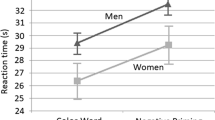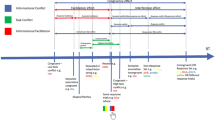Abstract
According to the attentional control theory of anxiety (Eysenck, Derakshan, Santos, & Calvo, 2007), anxiety impairs performance on cognitive tasks that involve the shifting function of working memory. This hypothesis was tested using a mixed antisaccade paradigm, in which participants performed single-task and mixed-task versions of the paradigm. The single task involved the completion of separate blocks of anti- and prosaccade trials, whereas in the mixed task, participants completed anti- and prosaccade trials in a random order within blocks. Analysis of switch costs showed that high-anxious individuals did not exhibit the commonly reported paradoxical improvement in saccade latency, whereas low-anxious individuals did. The findings are discussed within the framework of attentional control theory.
Article PDF
Similar content being viewed by others
References
Baddeley, A. [D.] (1986). Working memory. Oxford: Oxford University Press, Clarendon Press.
Baddeley, A. D., Chincotta, D., & Adlam, A. (2001). Working memory and the control of action: Evidence from task switching. Journal of Experimental Psychology: General, 130, 641–657.
Bar-Haim, Y., Lamy, D., Pergamin, L., Bakermans-Kranenburg, M. J., & van IJzendoorn, M. H. (2007). Threat-related attentional bias in anxious and nonanxious individuals: A meta-analytic study. Psychological Bulletin, 133, 1–24.
Barton, J. J. S., Cherkasova, M. V., Lindgren, K. A., Goff, D. C., Intriligator, J., & Manoach, D. S. (2002). Antisaccade and task switching: Studies of control processing in saccadic function in normal subjects and schizophrenic patients. In H. J. Kaminsk & R. J. Leigh (Eds.), Neurobiology of eye movements: From molecules to behavior (Annals of the New York Academy of Sciences, Vol. 956, pp. 250–263). New York: New York Academy of Sciences.
Bishop, S. J. (2007). Neurocognitive mechanisms of anxiety: An integrative account. Trends in Cognitive Sciences, 11, 307–316.
Bishop, S. [J.], Duncan, J., Brett, M., & Lawrence, A. D. (2004). Prefrontal cortical function and anxiety: Controlling attention to threat-related stimuli. Nature Neuroscience, 7, 184–188.
Bond, A. J., Shine, P., & Bruce, M. (1995). Validation of visual analogue scales in anxiety. International Journal of Methods in Psychiatric Research, 5, 1–10.
Cherkasova, M. V., Manoach, D. S., Intriligator, J. M., & Barton, J. J. S. (2002). Antisaccades and task-switching: Interactions in controlled processing. Experimental Brain Research, 144, 528–537.
Corbetta, M., & Shulman, G. L. (2002). Control of goal-directed and stimulus-driven activation in the brain. Nature Reviews Neuroscience, 3, 201–215.
De Jong, R., Berendsen, E., & Cools, R. (1999). Goal neglect and inhibitory limitations: Dissociable causes of interference effects in conflict situation. Acta Psychologica, 101, 379–394.
Derakshan, N., Ansari, T. L., Hansard, M., Shoker, L., & Eysenck, M. W. (in press). tAnxiety and inhibition: An investigation using the antisaccade task. Experimental Psychology.
Derakshan, N., & Eysenck, M. W. (1998). Working memory capacity in high trait-anxious and repressor groups. Cognition & Emotion, 12, 697–713.
Derryberry, D., & Reed, M. A. (2002). Anxiety-related attentional biases and their regulation by attentional control. Journal of Abnormal Psychology, 111, 225–236.
Elliman, N. A., Green, M. W., Rogers, P. J., & Finch, G. M. (1997). Processing-efficiency theory and the working-memory system: Impairments associated with sub-clinical anxiety. Personality & Individual Differences, 23, 31–35.
Ettinger, U., Ffytche, D. H., Kumari, V., Kathmann, N., Reuter, B., Zelaya, F., & Williams, S. C. R. (2008). Decomposing the neural correlates of antisaccade eye-movements using event-related fMRI. Cerebral Cortex, 18, 1148–1159.
Eysenck, M. W., & Calvo, M. G. (1992). Anxiety and performance: The processing efficiency theory. Cognition & Emotion, 6, 409–434.
Eysenck, M. W., Derakshan, N., Santos, R., & Calvo, M. G. (2007). Anxiety and cognitive performance: The processing efficiency theory. Emotion, 7, 336–353.
Eysenck, M. W., Payne, S., & Derakshan, N. (2005). Trait anxiety, visuospatial processing, and working memory. Cognition & Emotion, 19, 1214–1228.
Forster, K. I., & Forster, J. C. (2003). DMDX: A Window display program with millisecond accuracy. Behavior Research Methods, Instruments, & Computers, 35, 116–124.
Fox, E., Russo, R., Bowles, R., & Dutton, K. (2001). Do threatening stimuli draw or hold visual attention in subclinical anxiety? Journal of Experimental Psychology: General, 130, 681–700.
Fox, E., Russo, R., & Dutton, K. (2002). Attentional bias for threat: Evidence for delayed disengagement from emotional faces. Cognition & Emotion, 16, 355–379.
Garavan, H., Hester, R., Murphy, K., Fassbender, C., & Kelly, C. (2006). Individual differences in the functional neuroanatomy of inhibitory control. Brain Research, 1105, 130–142.
Hallet, P. E. (1978). Primary and secondary saccades to goals defined by instructions. Vision Research, 18, 1279–1296.
Harris, L. M., & Cumming, S. R. (2003). An examination of the relationship between anxiety and performance on prospective and retrospective memory tasks. Australian Journal of Psychology, 55, 51–55.
Herath, P., Klingburg, T., Young, J., Amunts, K., & Roland, R. (2001). Neural correlates of dual task interference can be dissociated from those of divided attention: An fMRI study. Cerebral Cortex, 11, 796–805.
Hester, R., & Garavan, H. (2005). Working memory and executive function: The influence of content and load on the control of attention. Memory & Cognition, 33, 221–233.
Hodgson, T. L., Golding, C., Molyva, D., Rosenthal, C. R., & Kennard, C. (2004). Eye movement during task switching: Reflexive, symbolic, and affective contributions to response selection. Cognitive Neuroscience, 16, 318–330.
Hutton, S. B., & Ettinger, U. (2006). The antisaccade task as a research tool in psychopathology: A critical review. Psychophysiology, 43, 302–313.
Kane, M. J., Bleckley, M. K., Conway, A. R. A., & Engle, R. W. (2001). A controlled-attention view of working-memory capacity. Journal of Experimental Psychology: General, 130, 169–183.
Kray, J. (2006). Task-set switching under cue-based versus memorybased switching conditions in younger and older adults. Brain Research, 1105, 83–92.
Kristjansson, A. J., Chen, Y., & Nakayama, K. (2001). Less attention is more, in preparation of antisaccade but not prosaccades. Nature Neuroscience, 4, 1037–1042.
LC Technology, Inc. (2003). Eyegaze development system: Development manual. Fairfax, VA: Author.
Logan, G. D. (2004). Working memory, task switching, and executive control in task span procedures. Journal of Experimental Psychology: General, 133, 218–236.
Manoach, D. S., Lindgren, K. A., Cherkasova, M. V., Goff, D. C., Halpern, E. F., Intriligator, J., & Barton, J. J. S. (2002). Schizophrenic patients show deficit inhibition but intact task-switching on saccadic tasks. Biological Psychiatry, 51, 816–826.
Massen, C. (2004). Parallel programming of exogenous and endogenous components in the antisaccade task. Quarterly Journal of Experimental Psychology, 57A, 475–498.
Meiran, N. (1996). Reconfiguration of processing mode prior to task performance. Journal of Experimental Psychology: Learning, Memory, & Cognition, 22, 1423–1442.
Miyake, A., Friedman, N. P., Emerson, M. J., Witzki, A. H., Howerter, A., & Wager, T. D. (2000). The unity and diversity of executive functions and their contributions to complex “frontal lobe” tasks: A latent variable analysis. Cognitive Psychology, 41, 49–100.
Monsell, S. (2003). Task switching. Trends in Cognitive Sciences, 7, 134–140.
Nieuwenhuis, S., Broerse, A., Nielen, M. M. A., & Jong, R. D. (2004). A goal activation approach to the study of executive function: An application to antisaccade tasks. Brain & Cognition, 56, 198–214.
Pashler, H., Johnston, J. C., & Ruthruff, E. (2001). Attention and performance. Annual Review of Psychology, 52, 629–651.
Reuter, B., Jäger, M., Bottlender, R., & Kathmann, N. (2007). Impaired action control in schizophrenia: The role of volitional saccade initiation. Neuropsychologia, 45, 1840–1848.
Rubinstein, J. S., Meyer, D. E., & Evans, J. E. (2001). Executive control of cognitive processes in task switching. Journal of Experimental Psychology: Human Perception & Performance, 27, 763–797.
Spielberger, C. C., Gorsuch, R. L., Lushene, R., Vagg, P. R., & Jacobs, G. A. (1983). Manual for the State-Trait Anxiety Inventory. Palo Alto, CA: Consulting Psychologists Press.
Wickens, C. D. (1984). Processing resources in attention. In R. Parasuraman & R. Davies (Eds.), Varieties of attention (pp. 63–101). New York: Academic Press.
Author information
Authors and Affiliations
Corresponding author
Additional information
The present work was supported by an ESRC Ph.D. studentship awarded to T.L.A. and was carried out under the supervision of N.D.
Rights and permissions
About this article
Cite this article
Ansari, T.L., Derakshan, N. & Richards, A. Effects of anxiety on task switching: Evidence from the mixed antisaccade task. Cognitive, Affective, & Behavioral Neuroscience 8, 229–238 (2008). https://doi.org/10.3758/CABN.8.3.229
Received:
Accepted:
Issue Date:
DOI: https://doi.org/10.3758/CABN.8.3.229




